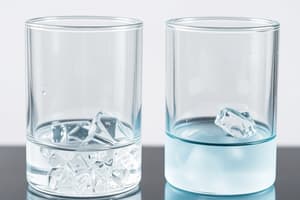Podcast
Questions and Answers
What is the density of the object given that it has a mass of 300g and displaces 50cm2 in water?
What is the density of the object given that it has a mass of 300g and displaces 50cm2 in water?
- 0.167g/cm3 (correct)
- 250g/cm3
- 2g/cm3
- 6g/cm3
Which of the following is an example of a change in only the physical properties of matter?
Which of the following is an example of a change in only the physical properties of matter?
- Boiling of water (correct)
- Baking a cake
- Rusting of iron
- Burning a match
In general, which of the following properties is a characteristic of both liquids and solids?
In general, which of the following properties is a characteristic of both liquids and solids?
- Ability to flow
- Fixed volume (correct)
- No pattern of molecule arrangement
- No specific shape
When a closed rigid vessel containing a gas is heated, what happens to the gas?
When a closed rigid vessel containing a gas is heated, what happens to the gas?
What structure of the atom did J.J. Thompson discover when he observed that cathode rays bend positively towards a charged plate?
What structure of the atom did J.J. Thompson discover when he observed that cathode rays bend positively towards a charged plate?
What is the density of the object if it has a mass of 300g and displaces 50cm2 in water?
What is the density of the object if it has a mass of 300g and displaces 50cm2 in water?
Which of the following is an example of a change in only the physical properties of matter?
Which of the following is an example of a change in only the physical properties of matter?
In general, which of the following properties is a characteristic of both liquids and solids?
In general, which of the following properties is a characteristic of both liquids and solids?
When a closed rigid vessel containing a gas is heated, what happens to the gas?
When a closed rigid vessel containing a gas is heated, what happens to the gas?
What structure of the atom did J.J. Thompson discover when he observed that cathode rays bend positively towards a charged plate?
What structure of the atom did J.J. Thompson discover when he observed that cathode rays bend positively towards a charged plate?
Flashcards are hidden until you start studying
Study Notes
Density Calculation
- Density is calculated using the formula: Density = Mass/Volume
- An object with a mass of 300g and a volume of 50cm³ has a density of 6g/cm³.
Changes in Physical Properties
- A change in only the physical properties of matter includes processes such as melting, freezing, or dissolving, which do not alter the chemical composition.
Characteristics of Liquids and Solids
- Both liquids and solids maintain a definite volume, distinguishing them from gases, which do not.
Behavior of Gas in a Heated Vessel
- When a closed rigid vessel containing a gas is heated, the pressure of the gas increases due to increased kinetic energy of the gas molecules.
J.J. Thompson's Discovery
- J.J. Thompson discovered the electron as a negative particle in atoms when he observed that cathode rays bend positively towards a charged plate, indicating the presence of negatively charged particles.
Studying That Suits You
Use AI to generate personalized quizzes and flashcards to suit your learning preferences.




